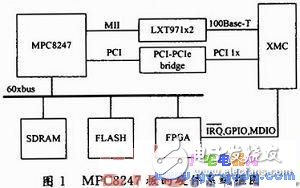This paper first introduces the hardware platform of the embedded power exchange system based on MPC8247, and focuses on how to develop the embedded power exchange system on the MPC8247 processor, including the construction of the development environment, the U-Boot modification of the system boot module, and the cutting of the kernel. And porting, exchange software SDK porting, application software ZebOS compilation, etc. The field application of the power exchange equipment (DPN8000) proves that the system has the advantages of small size, low power consumption and high bandwidth, and has contributed to the development of power communication networks and systems.
With the development of power communication and the increase of power traffic, there is a higher requirement for the I/O processing capability of embedded power devices, especially for voice, data and video services that provide high capacity, high speed and high bandwidth. Supported embedded access devices, therefore, high-capacity embedded power devices with high performance and low power consumption are favored.
Freescale's PowerPC processor MPC8247 has the advantages of high integration, low power consumption and support for a wide range of peripherals. It is also equipped with IP Infusion's ZebOS(R) software for fast communication and high throughput data processing. The network improves the performance of the network, reduces the cost of the network infrastructure and increases the revenue of the operators and enterprises, and solves the problems encountered in the embedded power communication equipment. In this paper, the development of high-capacity power optical switching equipment OLT (DPN8000) is introduced. The hardware design of the power switching system and the development of the embedded switching system are introduced. The key points are how to implement the embedded power switching system.
1 Overview of the hardware platformThe MPC8247 board mainly includes the CPU subsystem, and its system block diagram is shown in Figure 1.

MPC8247 is a kind of Freescale MPC82XX series microprocessor, which is mainly composed of G2_LE core (a kind of PowerPC 603e core), system interface unit SIU and communication processing module CPM. Support 60x bus, its data line width is 64 bits, address line is 32 bits; support PCI / LOCAL bus, its data line width is 32 bits, the address line is 32 bits. The PowerPC8247 core operates at up to 400 MHz and the CPM operates up to 200 MHz. The peripheral interfaces are roughly as follows:
(1) SDRAM: 64-bit 256 MB capacity, consisting of four 64 MB MT48LC32M16A2TG, using Local Bus's D[0:63] and A[16:28].
(2) FLASH: 32 MB capacity, consisting of 2 16 MB S29GL128N. In the design, the FLASH works in WORD mode, using Local Bus's D[0:31] and A[4:29].
(3) PCI bus: A 32-bit 66 MHz PCI bus is introduced, which is converted into a PCIe bus through the PCI-PCIe bridge PI7C9X10, and connected to the backplane switching chip BCM56 338 via the XMC connector as the management port of the FabrIC chip.
2 Construction of the embedded system development environment2.1 Preparing the development environment
Usually embedded in Linux development is divided into host system and target system, they are interconnected through the network interface and serial port, the network port is generally used to download programs and kernel image files, the serial port is generally used as a console console, in the host through the HyperTerminal Command interaction with the target system, just like the keyboard and display of a PC.
The embedded Linux system model is shown in Figure 2.

2.1.1 Installation Development Compilation Environment
Usually the CPU of the host and the target board are different and need to be cross-compiled. The GNU GCC toolchain was used in this project. The PowerPC version of GNUGCC requires cross-compilation, and all source code can be obtained from the FSF FTP site.
The whole process is as follows: download source files, patches, and build compiled directories; build kernel header files; build binary tools (binuTIls); build initial compilers (bootstrap gcc); build C libraries (glibc); build full compilers (full Gcc).
After installation, you can use "which ppc_8xx.gcc" to find out where the generated target executable file is.
2.1.2 Configuring DHCP
The host system needs to set up a DHCP server for the target system to obtain an IP address when booting with BOOTP. Before setting, you must first know the MAC address of the target system, and ensure that the host system has a DHCPD server installed. Modify /etc/dhcpd in the virtual machine. Conf configuration file, then restart the dhcpd service with the following command:
#/etc/init. d/dhcpd restart
At the same time, the dhcpd service is started, so that the host automatically starts the service every time it starts.
2.1.3 Configuring a TFTP Server
A TFTP (Simple File Transfer Protocol) server is used by the target system to obtain executable code or kernel image files from the host system.
Log in to the host system as a superuser and edit the following files:
#vim/etc/xinetd. Conf
Remove the comment from the following line:
#tftp dgram udp wait root/usr/sbin/tcdp in. Tftpd
Create the tftpboot directory in the root directory:
#mkdir tftpboot
Copy each compiled target code to this directory, start the TFTPD service in the system service (run #setup, select in "System servICes".) Then execute: #service xinetd restart.
2.1.4 Configuring NFS
NFS mainly provides a root file system (Root Filesystem) to the target system.
First, edit the configuration file /etc/exporlts:
#vi exports
If it doesn't exist, add a line:
/home/com_target_master*(rw,no_root_squash)
Smart Bms,Bms For Battery,Bms For Lithium Battery,Bms Module
HuiZhou Superpower Technology Co.,Ltd. , https://www.spchargers.com